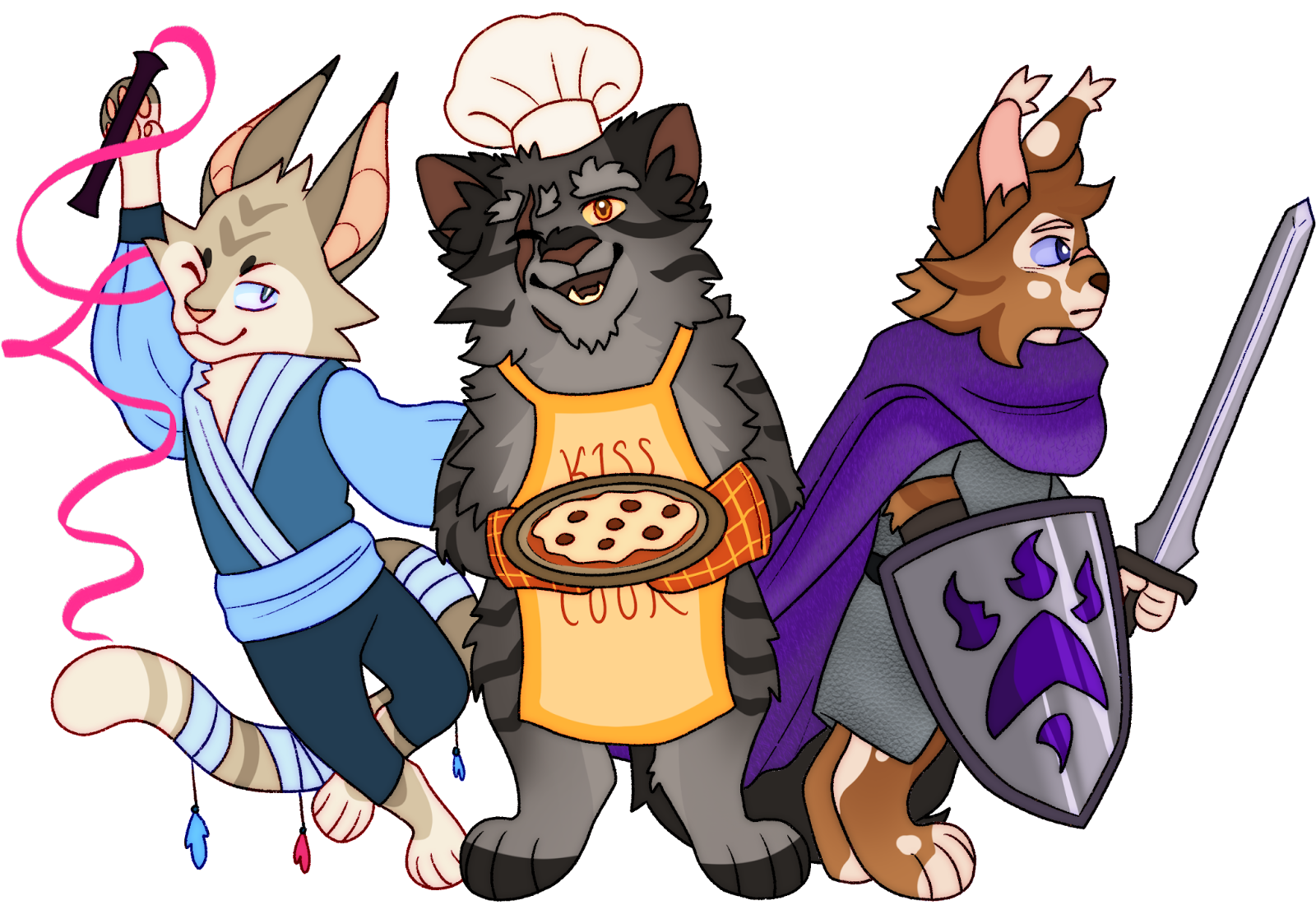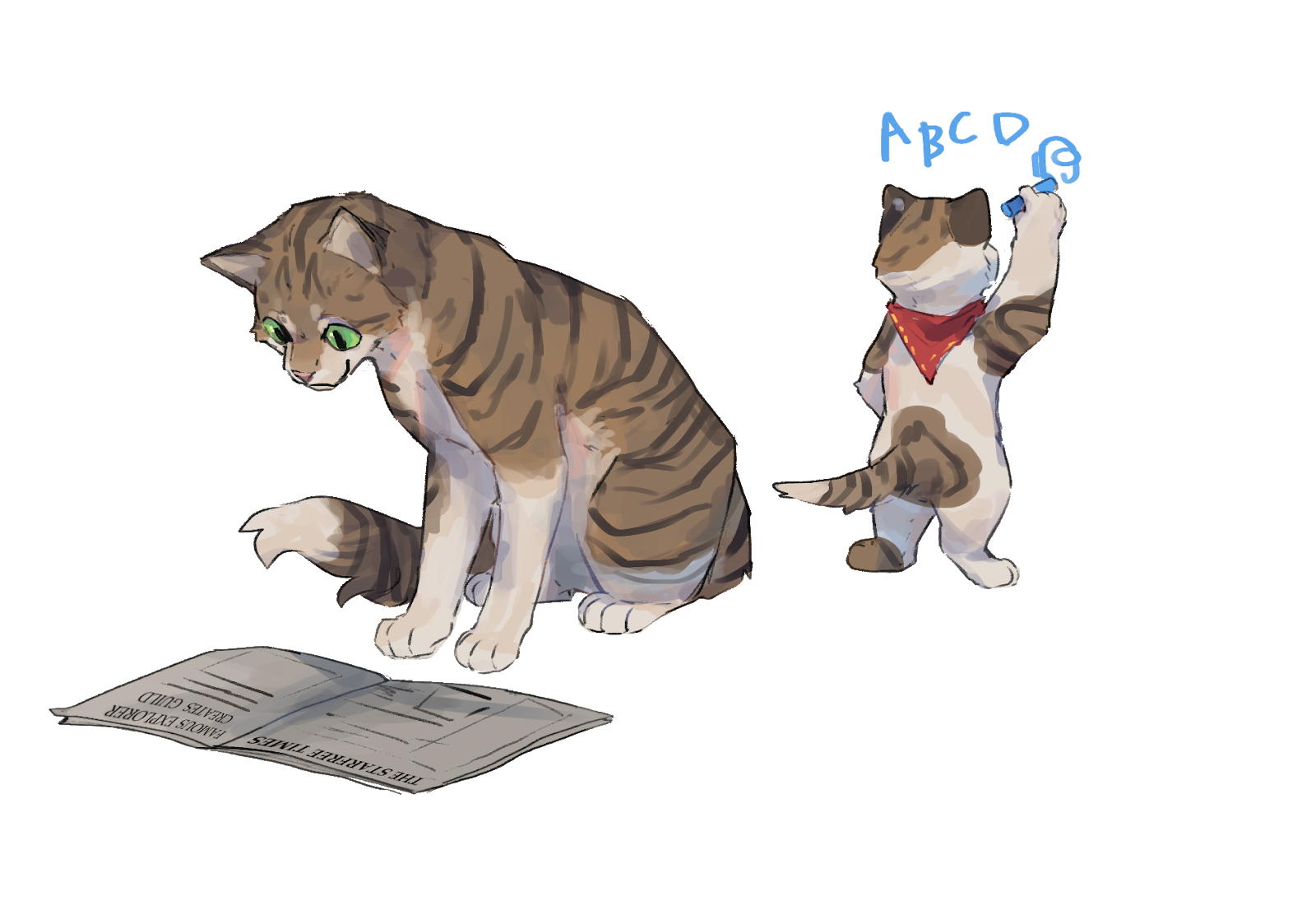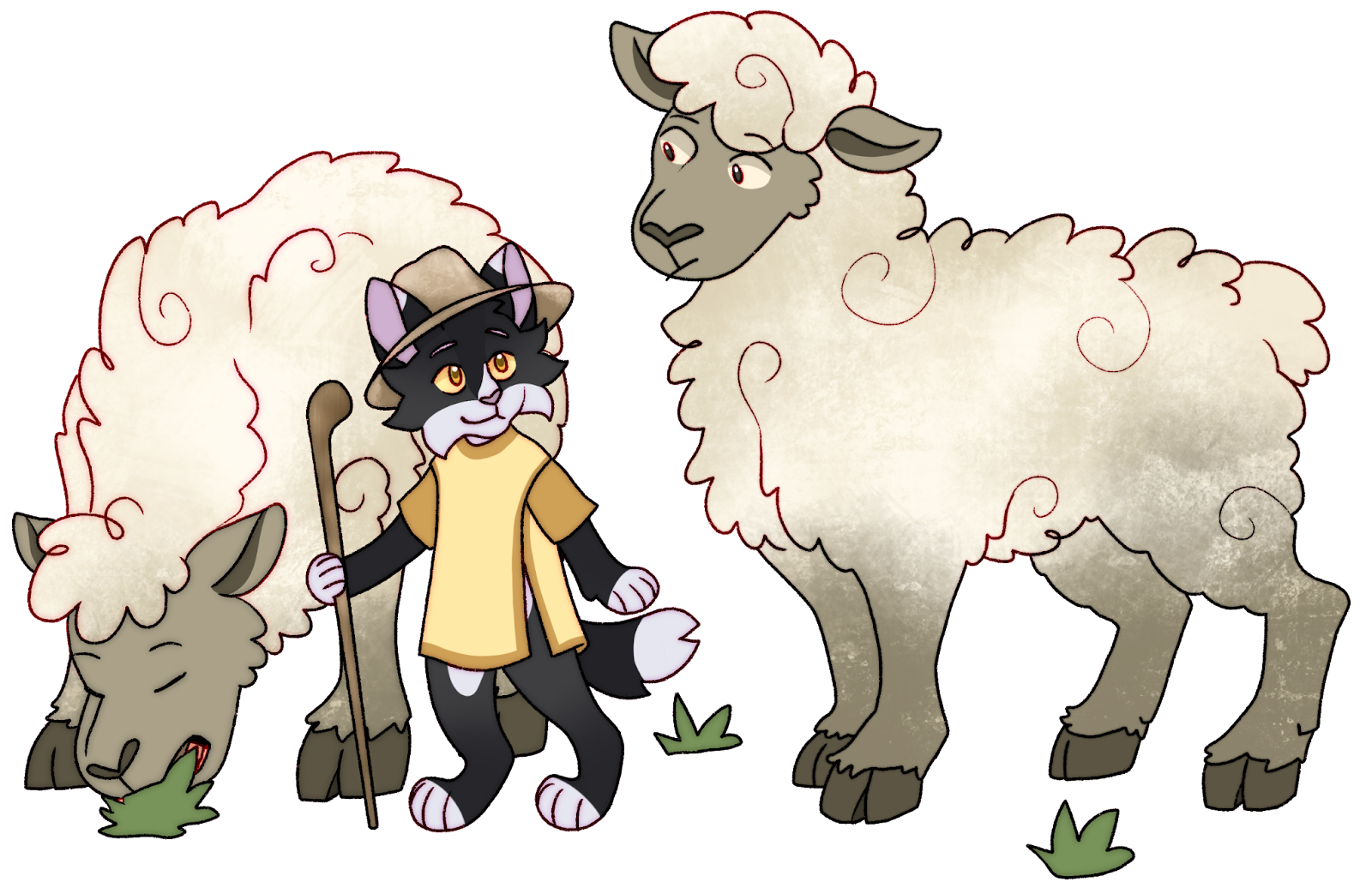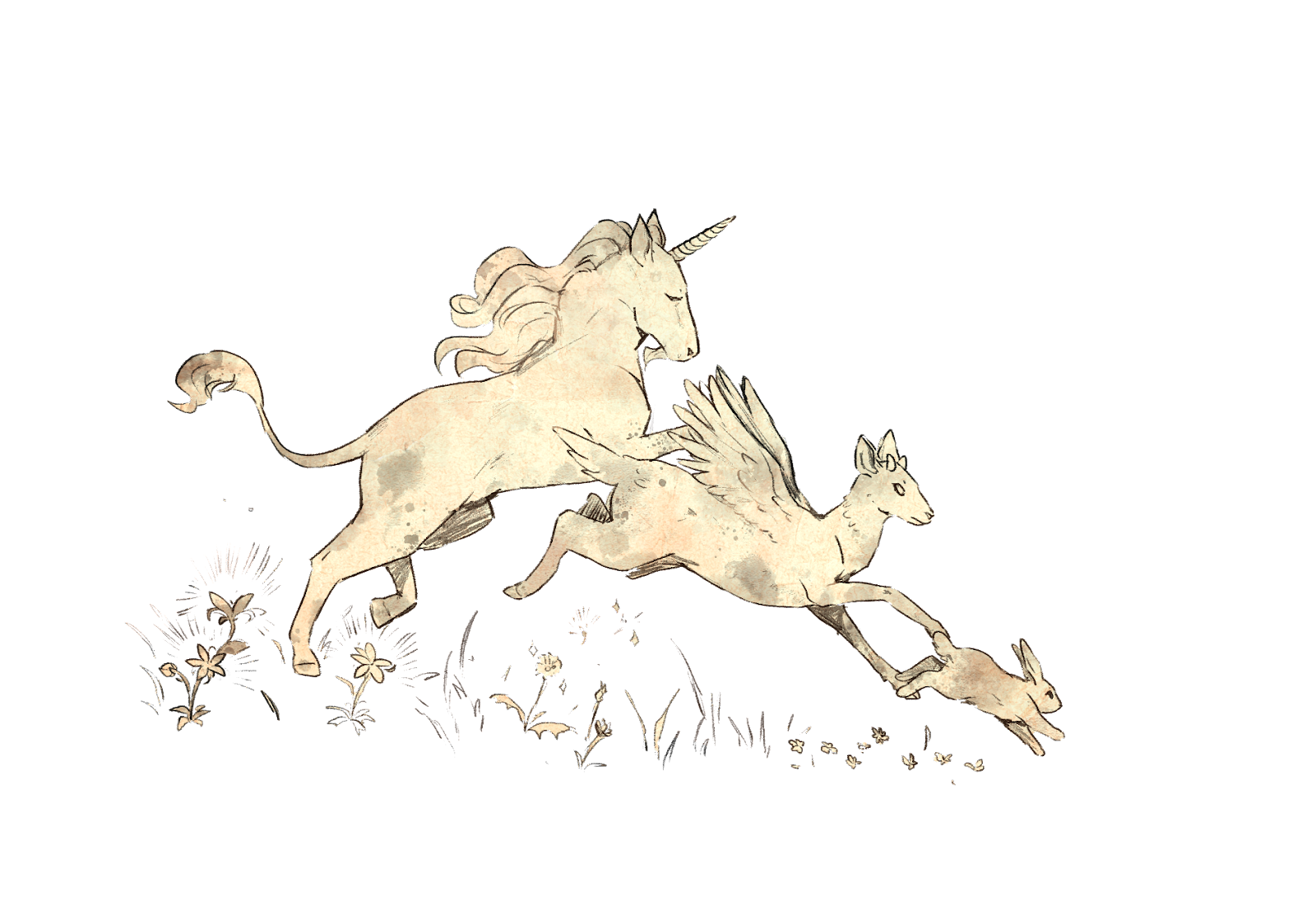Government & Economics
There is no overarching government or power binding the independent kingdoms and villages that have sprouted across the land. These permanent settlements vary in architecture and development depending on environment and culture; some cats prefer to live close to their roots in natural dens, while others may build houses out of common materials, such as brick or stone.
As civilization is mostly scattered and disconnected from one another, settlements have each made their own, unique currencies for daily use. However, with travelers becoming more common, many places have either agreed upon accepting a universal currency or trade goods in place of coin.

The diversity of the region’s environment—ranging from desert to rainforest—brings with it a wide variety of occupations for catfolk to pursue: farmers, fishers, knights, bookkeepers, mechanics, tailors, artists, chefs, performers, you name it! In recent times, researchers with an interest in magic have been especially important to the understanding and innovation of magic.
Environment and Travel
The wilderness that stretches between settlements is vast and dangerous. Known by most as the “Roamwilds”, these wilds are dangerous, matched by none except the most powerful of cats. Many catfolk fall victim to the beasts that hunt the Roamwilds if they do not keep their eyes up and claws sharp.
Most stick to the safety of towns, protected by the company of others, and safe roads have been established to connect towns to one another. As cats grow in power with the help of magic technology, travel has become easier than ever before. The larger a city and its population, the more well-traveled roads are likely to connect to it, though most towns have at least one secure path.
Two or Four Legs?
All catfolk are able to function both on two or four legs, but how much of their life is spent on either varies on many aspects such as culture, class, environment, and practicality. Both modes are equally modern and common; the pros and cons depend purely on the situation.
Richer districts often function on two legs at all times: a unique aspect of highbrow culture due to the nature of their work. Places of wealth and status employ work in academia, science, culinary arts, and business, and these spaces may demand cats work on two legs.
More laborious jobs such as combat, farming, or exploration require flexibility in mobility. Catfolk in these environments must be comfortable working on both two and four legs depending on the situation and benefits.
Most catfolk are likely to have enough motor skills to switch between a two-legged stance and a four-legged one depending on whichever situation is most appropriate or comfortable. Common establishments are built to cater to either stance, with furniture, tools, and homes being accessible to cats of all kinds.
A cat on four legs will almost always be faster than on two. Carrying lighter objects in ones’ mouth allows for more stability, though heavier objects favour being carried with the front paws for center of gravity and support. Practical pouches styled to be used in either stance are as widely utilized as well.
These guidelines are most likely to be followed in the canon locations of our world. However, these rules are very much allowed to be ignored for your own character and their origins! Upbringing and culture can change how a cat can maneuver, and you are welcome to be creative!
Clothing
Catfolk wear clothing in varying amounts; any level of dress is acceptable in Waywardia as a whole, from no clothes to a full outfit plus accessories. Some catfolk may dress themselves more or less than others depending on culture, and clothing styles may be influenced by culture or environment. For example, catfolk who live in the desert do not dress like catfolk who live in the tundra.
Most catfolk do not wear shoes or socks, as they adversely affect mobility and cover up their claws. It is up to each individual whether or not they do wear them, however, and some tailors have even designed gloves that leave openings for toes, claws, or both, allowing catfolk to cover up while remaining comfortable and safe. There are designs for both front and back limbs.
Education
Many schooling systems are present in Waywardia, which can range from homeschooling to higher academia in the form of institutions or universities. Though the specifics and depth of education will vary from land to land, an average cat is likely to have the basic ability to read common language and understand common sign language. Sign in Waywardia utilizes a mix of the ears, tail, and paws, and even cats who cannot stand on their hind legs can rest on their haunches to sign.
All publications include braille on their writings, allowing any cat to engage with a diverse array of texts and receive a formal education, should they choose to pursue one. Furthermore, many catfolk are employed to read text out loud for the visually impaired, and magic technology has made strides for accessibility by similarly reading texts out loud. These devices speak in the voice of the cat who built them. Additionally, speeches, school lectures, and other forms of speaking to a crowd include catfolk who sign alongside the speaker, which allows hearing impaired catfolk to attend them.

Religion
The diversity of catfolk society comes with it a diversity in religious beliefs. Many religions, whether isolated or widespread, are based on phenomenons of magic in the natural world. Life-changing encounters with magic can form the basis of an entire belief system, in which a cat could believe themselves blessed, cursed, or simply that there is an otherworldly entity watching over them. Additionally, many villages are settled near places of recurring magic; some catfolk do so for the purpose of worship, and others believe magic can offer protection. However, some villages are built far from magic hotspots due to superstition about potential danger.
Calendar System
WTW has its own calendar, but the names closely reflect the months in English! And rather than months, the characters call them “moons.” The names are as follows:
Janu, Febru, Mars, Aphril, Maai, Joone, Jouli, Augusta, Septra, Octobra, Nova, Desembra
So, for example, a character might say “I’m working through the whole moon of Febru,” or “I was born during the moon of Octobra.” This is all to easily distinguish in-character dates from real life ones to prevent confusion!
Food
Catfolk are omnivorous, and though they favor non-meat, meat is still essential to their diet. Farming is a widespread and profitable profession, allowing easy access to fruits and vegetables. Domesticated livestock such as poultry, pigs, and sheep are commonly raised as well. Development in magic has allowed for advancements in domesticating other livestock, such as shrinking larger animals like cows to a more manageable size.

Some communities or individuals may still prefer to hunt prey or forage for plants, while others rely on the supply of local farmers and fishers. Meals are usually prepared traditionally, and meat is cooked. Some cats may prefer to eat their food raw, but this is generally taboo in high society.
Geography
Magic can cause abnormal formations across the land, lending to the environment’s varied ecosystems. Evergreen forests can neighbor deserts; isolated tundras flank swamps; mountains border flatlands. The Roamwilds are the areas most commonly hosting powerful, unexplainable, and untameable magic: and for this reason, they are avoided unless it is absolutely necessary to traverse them. While some magic can outwardly seem benevolent, all magic has the potential to be a deadly thing.
Flora & Fauna

Flora and fauna can come under three types in relation to magic: non-magic, magic-touched, and magical.
The most common are the non-magic animals and plants. A wide variety of animals exist across the land, all according to their specific biome; for instance, lions live in the savannah, while bears live in the forest. If an animal is alive and not extinct in the real world, they may exist in Waywardia. The same can be said for flora.
Magic-touched flora and fauna may refer to a single organism, or population that has been changed through magic in some way. They manifest as hybrids, abnormal colours, or changes that may have affected the subject but does not allow them to conjure magic of their own. Trees that are either too small, plants that unnaturally grow in places they shouldn’t, animals such as traditional griffons or manticores (or any combination conceivable) are declared as magic-touched. The magic-touched may be harder to tame, being more unpredictable from the magic that’s affected them and less common to find, though still very feasible to the brave, smart or resilient. With the advancement of magic technology, magic-touched flora and fauna can be made artificially.
The Magical refers to plants and animals that actively channel magic in some way. Traditional unicorns and their ability to heal poison or an ecosystem of plants that drain life come under this category.
These beasts are far more elusive. They often possess magical powers that can be used for different reasons, whether those reasons be healing or destruction. Because of the sheer rarity and power of these creatures, sightings often spark superstition or even entire religious beliefs, garnering horror and worship wherever they appear. For example, for a family to spot a unicorn near their village may be viewed as a blessing; to spot a dragon overhead, however, could spell certain doom and would require excessive worship and sacrifice. Magic-harboring plant species are more common than appearances of these beasts, though still more difficult to find than normal plants. They can possess any number of magical qualities and are often sought for medical reasons, but may be too fickle to properly cultivate without the right tools.
Additionally, pets are not uncommon for catfolk, with many owning birds, reptiles, rodents, insects, and fish of all kinds. Some have practical purposes such as pulling carts and carrying messages, while some are merely companions. For more information on what catfolk can bring to the Wayseekers Guild, please look here.